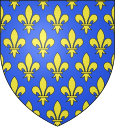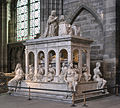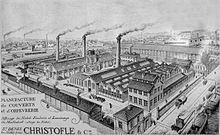Saint-Denis (Seine-Saint-Denis)
| Saint-Denis | ||
|---|---|---|

|
|
|
| region | Île-de-France | |
| Department | Seine-Saint-Denis | |
| Arrondissement | Saint-Denis | |
| Canton |
Saint-Denis-1 (main town) Saint-Denis-2 (main town) |
|
| Community association |
Métropole du Grand Paris and Plaine Commune |
|
| Coordinates | 48 ° 56 ' N , 2 ° 21' E | |
| height | 23-46 m | |
| surface | 12.36 km 2 | |
| Residents | 111,135 (January 1, 2017) | |
| Population density | 8,992 inhabitants / km 2 | |
| Post Code | 93200 | |
| INSEE code | 93066 | |
| Website | http://ville-saint-denis.fr/ | |
Saint-Denis [ ˌsɛ̃dəˈni ] is a French city with 111,135 inhabitants (as of January 1, 2017) in the Seine-Saint-Denis department and is the official seat of the sub-prefecture in the Saint-Denis arrondissement . It is located immediately north of Paris and today forms part of the Banlieue . The inhabitants are called Dionysia .
history
The former abbey church of Saint-Denis , consecrated to Saint Dionysius of Paris , was the burial place of almost all Frankish and later the French kings since 564 AD . The Frankish ruler Karl Martell (686–741) was buried here as well. This tradition lasted until Charles X (1824–1830), the last Bourbon king on the French throne.
The new construction of the monastery church started in 1147 according to the plans of Abbot Suger is considered the beginning of the Gothic period . On November 10, 1567, the Battle of Saint-Denis (1567) , a dispute at the beginning of the Second Huguenot War , and another ( Battle of Saint-Denis (1678) ) took place as the last battle of the Dutch War .
In the time of the French Revolution , the city was in 1793 in the wake of the general secularization efforts in Franciade renamed. In 1803 it got its original name again.
Industrialization began in the city at the end of the 19th century , and it became one of the first strongholds of the labor movement and the French Communist Party (PCF) , which is still the mayor today. Since the 1950s, there have been numerous social housing in prefabricated construction ( habitation à loyer modéré - HLM ) and a high proportion of immigrants from the Maghreb and sub-Saharan Africa .
Saint-Denis has been connected to the Paris subway network since 1911 .
More recently, Saint-Denis has become famous for the construction of the Stade de France stadium , which was completed in 1997 and has a capacity of 75,000.
Serious riots also took place in Saint-Denis in the wake of the unrest in France in 2005 .
Religions
Saint-Denis is the seat of the Roman Catholic diocese of Saint-Denis and is one of the centers of Islam in France .
Culture and sights
See also: List of Monuments historiques in Saint-Denis (Seine-Saint-Denis)
- Théâtre Gérard Philipe
- Art History Museum Saint-Denis: European Museum of the Year 1982
- Suprême NTM , French hip hop group
cathedral
The Cathedral of Saint-Denis (French: Basilique Saint Denis ) is a former abbey church . It is a minor basilica and was promoted to cathedral of the diocese of Saint-Denis in 1966 . During the French Revolution in 1793 the graves were looted and the sculptures in the church were badly damaged. The cultural monument, which has been classified as a Monument Historique since 1862, is of great art historical importance, as the first pointed arched cross-ribbed vaults were built in its choir, begun in 1140 , so that Saint-Denis is considered the cradle of Gothic .
- Images of the cathedral
Gothic cathedral of Saint Denis
Sports
The Stade de France (German: Stadium of France) is by far the largest stadium in the country with a capacity of 81,338 spectators for football and rugby matches. It was named a five-star stadium by UEFA. The most important events are home games of the French national soccer team and the rugby team , the final for the French soccer and league cup and the final of the rugby championship Top 14 . With the help of sliding grandstands, the Stade de France can also be prepared for athletics events such as the IAAF Diamond League , with the capacity being reduced to 75,000 spectators. Concerts and open-air shows are also held here regularly. At concerts, the stadium, including the interior, offers space for over 90,000 visitors. The Stade de France hosted the final matches of the 1998 soccer World Cup and the 2016 European soccer championship , as well as the 2003 World Athletics Championships . It is also intended as the Olympic stadium for the 2024 Summer Olympics .
Saint-Denis has already started / finished several stages in the Tour de France , including in 1984 and 2003 .
Town twinning
Saint-Denis has signed partnership and cooperation agreements with
- Larbaâ Nath Irathen, Algeria , since 1998
- Gera , Thuringia , Germany, since 1959
- Tuzla , Bosnia and Herzegovina , since 1998
- North Lanarkshire , Scotland , since 1963
- Nazareth , Israel , since 2005
- Sesto San Giovanni , Lombardy , Italy, since 1961
- Djélébou, Karokoro and Sahel, rural communities in Mali , since 1996
- Tiznit , Morocco , since 2003
- Rafah , Palestinian Territories , since 2006
Economy and Infrastructure
history
At the time of industrialization, Saint-Denis was an important location for the metal and heavy industry (including railway and automobile construction) and electrical industry. The most famous former companies included:
- Hotchkiss et Cie (including Hotchkiss-Grégoire )
- Delaunay-Belleville
- Christofle : The plant in Saint-Denis was opened in 1876 and remained in operation until 2004
- Ateliers de Construction Mécanique l'Aster
Well-known products of the time were u. a. the dining car and later saloon car from Compiègne and the tabulation machines from Société anonyme des machines à statistiques (SAMAS), a French subsidiary of Powers Accounting Machine Company .
Today's economic structure
Even today, numerous companies in the metal industry and in automobile and vehicle construction are at home. Today Saint-Denis is also an important location for the service industry as well as a media and multimedia location. Some of the largest and best-known companies based in Saint-Denis today include:
- Société nationale des chemins de fer français (SNCF)
- Giant
- Airness
- Faiveley Transport
- Cegelec
- T-Systems France
- vente-privee.com
- Equinix , two data centers
- EuropaCorp
- AB Groupe
- NextiraOne
traffic
The city is fully connected to the local transport network in the greater Paris area. On the one hand, there is a connection to the Transilien suburban network at Gare Saint-Denis . It is also possible to use the RER D there , which enables a fast connection to the central Châtelet - Les Halles transfer station . The city is also the starting point of Metro line 13 in the direction of Châtillon-Montrouge (with the stations Basilique de Saint-Denis , Carrefour Pleyel , Saint-Denis - Porte de Paris , Saint-Denis - Université ). The city is also crossed by the oldest post-war Paris tram line T 1 .
Saint-Denis is connected to the Paris – Lille line via the Saint-Denis train station . There is also a connection to the Seine via the Canal Saint-Denis .
Saint-Denis is on the national roads N 14a and N 301 as well as on the A 1 autoroute . The bridge Pont de l'Île Saint-Denis leads from Saint-Denis over two arms of the Seine and the Île Saint-Denis with the municipality of L'Île-Saint-Denis to Villeneuve-la-Garenne on the western side of the Seine.
education
Since 1980, Saint-Denis has been the seat of the University of Paris 8 Vincennes-Saint Denis (University of Paris VIII) with around 26,000 students today.
Personalities
literature
- Le Patrimoine des Communes de la Seine-Saint-Denis. Flohic Éditions, 2nd edition, Paris 2002, ISBN 2-84234-133-3 , pp. 315–345.
Web links
- City website
- Saint-Denis, une ville au Moyen-Âge , history portal (Ministère de la culture et de la communication)
Individual evidence
- ↑ Website Saint-Denis - ville monde ( Memento des Originals of February 22, 2017 in the Internet Archive ) Info: The archive link was inserted automatically and has not yet been checked. Please check the original and archive link according to the instructions and then remove this notice. , accessed February 21, 2017
- ↑ cf. also Business Agency of the Paris region: Seine-Saint-Denis (93) ( page no longer available , search in web archives ) Info: The link was automatically marked as defective. Please check the link according to the instructions and then remove this notice. , accessed June 25, 2012.










